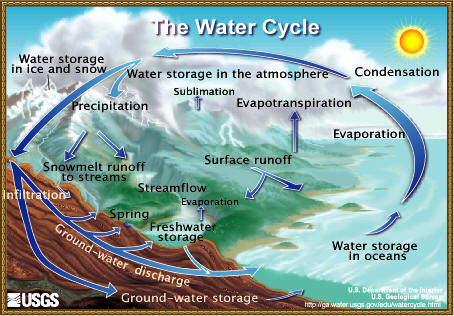water cycle

Earth's water is always in movement, and the water cycle, also known as the hydrologic cycle, describes the continuous movement of water on, above, and below the surface of the Earth. Since the water cycle is truly a "cycle," there is no beginning or end. Water can change states among liquid, vapor, and ice at various places in the water cycle, with these processes happening in the blink of an eye and over millions of years.
Although the balance of water on Earth remains fairly constant over time, individual water molecules can come and go in a hurry. The water in the apple you ate yesterday may contain molecules that fell as rain half-way around the world last year or was drunk by a dinosaur 100 million years ago.
Earth's water supply
In all, the Earth's water content is about 1.39 billion cubic kilometers (331 million cubic miles) and the vast bulk of it, about 96.5%, is in the global oceans. Approximately 1.7% is stored in the polar icecaps, glaciers, and permanent snow, and another 1.7% is stored in groundwater, lakes, rivers, streams, and soil. Finally, a thousandth of 1% exists as water vapor in the Earth's atmosphere.
| One estimate of global water distribution | |||
|---|---|---|---|
| Volume (1000 km3) |
Percent of total water | Percent of fresh water | |
| Oceans, seas, & bays | 1,338,000 | 96.5 | - |
| Ice caps, glaciers, & permanent snow | 24,064 | 1.74 | 68.7 |
| Groundwater | 23,400 | 1.7 | - |
| Fresh | (10,530) | (0.76) | 30.1 |
| Saline | (12,870) | (0.94) | - |
| Soil moisture | 16.5 | 0.001 | 0.05 |
| Ground ice & permafrost | 300 | 0.022 | 0.86 |
| Lakes | 176.4 | 0.013 | - |
| Fresh | (91.0) | (0.007) | 0.26 |
| Saline | (85.4) | (0.006) | - |
| Atmosphere |
12.9 | 0.001 | 0.04 |
| Swamp water | 11.47 | 0.0008 | 0.03 |
| Rivers | 2.12 | 0.0002 | 0.006 |
| Biological water | 1.12 | 0.0001 | 0.003 |
| Total | 1,385,984 | 100.0 | 100.0 |
| Source: Gleick, P. H., 1996: Water resources. In Encyclopedia of Climate and Weather, ed. by S. H. Schneider, Oxford University Press, New York, vol. 2, pp.817-823. | |||
